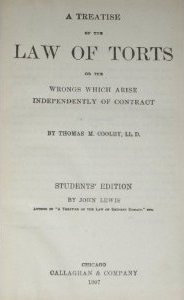In order to constitute
an act or omission a tort, there must be some act or omission on the part of
one party and such an act should constitute one of the torts; and the act or
omission should result in causing some damage or injury or violation of legal
rights vested in the other party.
Act or Omission
In order to constitute
a tort, there must be an act or omission. It may be either negative or
positive. In either case, it is the act which is considered as unlawful. When a
person has a legal duty to perform and if he fails to perform, then he can be
made liable.
Resultant Damage
Mere act or omission
or failure to perform an obligation or a duty will not constitute a tort,
unless otherwise it results in some injury or damage to the person suing for violation
of his legal right. This can be explained with the help of two maxims
injuria sine damno and damnum sine injuria.
Injuria sine damno
If a legal right has
been violated, remedy must be provided. This principle lays down that, if an
absolute right of an individual has been violated, an action lies even if no
injury or damage results. It is actionable per se. i.e., no need to prove
any damage. E.g. Trespass.
On the other side, if a
qualified right has been violated no action lies unless actual damage or injury
has resulted. Hence, in case of nuisance or malicious prosecution, actual
damage or injury must be proved.
In Ashby v. White, the
plaintiff was a qualified voter at a parliamentary election. However, the
returning officer, the defendant in the present case wrongfully refused to take
plaintiff’s vote. Though no loss was suffered by such a refusal, as the
candidate to whom the plaintiff actually wanted to vote won the election, court
held the defendant liable for committing a tort.
Damnum sine injuria
If there is no
violation of legal right, even though the act of one party causes harm or
injury to the other, no action can be taken. In other words, howsoever gross
the damage or injury may be, if there is no violation of legal right, damages
or relief cannot be claimed.
In Gloucester
Grammar School case, the defendant, a school master set up a rival school
to that of the plaintiff of the present case in the same locality. As a result,
the plaintiff had to reduce their fees so as to compete with the defendant. It was
held by the court that, the defendant had not committed any tort. Hence, the
plaintiff is not entitled for any remedy.




No comments:
Post a Comment